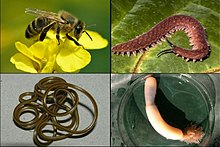Ecdysozoa
| Ecdysozoa | |
|---|---|

| |
| Scientific classification | |
| Domain: | Eukaryota |
| Kingdom: | Animalia |
| Subkingdom: | Eumetazoa |
| Clade: | ParaHoxozoa |
| Clade: | Bilateria |
| Clade: | Nephrozoa |
| (unranked): | Protostomia |
| Superphylum: | Ecdysozoa Aguinaldo et al., 1997 |
| Phyla | |
| |
Ecdysozoa (
A large study in 2008 by Dunn et al. strongly supported the monophyly of Ecdysozoa.[7]
The group Ecdysozoa is supported by many morphological characters, including growth by ecdysis, with moulting of the cuticle – without mitosis in the epidermis – under control of the prohormone ecdysone, and internal fertilization.[8]
The group was initially contested by a significant minority of biologists. Some argued for groupings based on more traditional taxonomic techniques,[9] while others contested the interpretation of the molecular data.[10][11]
Etymology
The name Ecdysozoa is "scientific" Greek, derived from ἔκδυσις (ékdusis) "shedding" + ζῷον (zôion) "animal".
Characteristics
The most notable characteristic shared by ecdysozoans is a three-layered
Phylogeny
The Ecdysozoa include the following phyla:
A modern consensus phylogenetic tree for the protostomes is shown below.[17][18][19][20][21][22] It is indicated when approximately clades radiated into newer clades in millions of years ago (Mya); dashed lines show especially uncertain placements.[23]
The phylogenetic tree is based on Nielsen et al.[24] and Howard et al.[25]
| Bilateria |
| ||||||||||||
Older alternative groupings
Articulata hypothesis
The grouping proposed by Aguinaldo et al. is almost universally accepted, replacing an older hypothesis that
Inclusion of theCoelomata hypothesis
Before Aguinaldo's Ecdysozoa proposal, one of the prevailing theories for the evolution of the
References
- ^ S2CID 246494357. Retrieved 2023-07-30.
- S2CID 251646316.
- PMID 33228518.
- PMID 18192181.
- .
- S2CID 4334033.
- ^ S2CID 4397099.
- ISBN 9780198571810
- ISBN 978-0-19-850682-9.
- ^ PMID 11985779.
- .
- ISBN 0-03-056747-5.
- S2CID 205244325.
- ^ The mouth apparatus of the Cambrian gilled lobopodian Pambdelurion whittingtoni
- ^ "Panarthropoda". Paleos (palaeos.com). Invertebrates. Archived from the original on 2007-02-07. Retrieved 17 February 2007.
- S2CID 22823313.
- S2CID 32169826.
- PMID 28377584.
- S2CID 205239797.
- ^ "Palaeos Metazoa: Ecdysozoa". palaeos.com. Retrieved 2017-09-02.
- PMID 26605063.
- ISBN 0-19-850682-1.
- PMID 18192191.
- S2CID 52067372.
- S2CID 246494357.
- S2CID 1416582.
- ISBN 978-0-19-960603-0.
- . — in support of clade Ecdysozoa
- .
- PMID 18192193.
- ^ "The Darwin-Wallace Medal" (Press release). The Linnean Society of London. Retrieved 28 February 2018.
- PMID 10781043.
- PMID 15703245.
External links
- "Ecdysozoa introduction". Phyla. University of California Museum of Paleontology (ucmp.berkeley.edu). Berkeley, CA.
- "Ecdysozoa". Kingdoms / Animalia. palaeos.com. Archived from the original on 2003-03-13.
- "Tardigrades and Ecdysozoa". Tardigrades. nematodes.org. Archived from the original on 2008-06-18.
- Schmidt-Rhaesa, Andreas; Bartolomaeus, Thomas; Lemburg, Christian; Ehlers, Ulrich; Garey, James R. (December 1998) [6 January 1999 (online publication)]. "The position of the Arthropoda in the phylogenetic system". on 2010-05-10.
- Garey, James R.; Schmidt-Rhaesa, Andreas (December 1998) [3–7 January 1998]. Essential role of "minor" phyla in understanding animal evolution. Annual Meeting of the Society for Integrative and Comparative Biology, 3–7 January 1998, Boston, Massachusetts. Symposium on Evolutionary Relationships of Metazoan Phyla: Advances, problems, and approaches. JSTOR 4620218. Archived from the originalon 2003-03-13. Retrieved 2023-07-30 – via chuma.cas.usf.edu/~garey.
- "Nematomorpha". nematomorpha.net.


